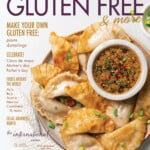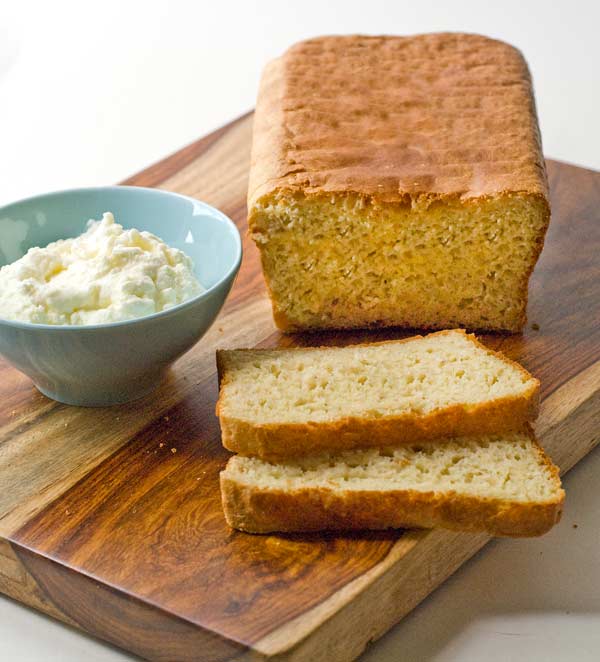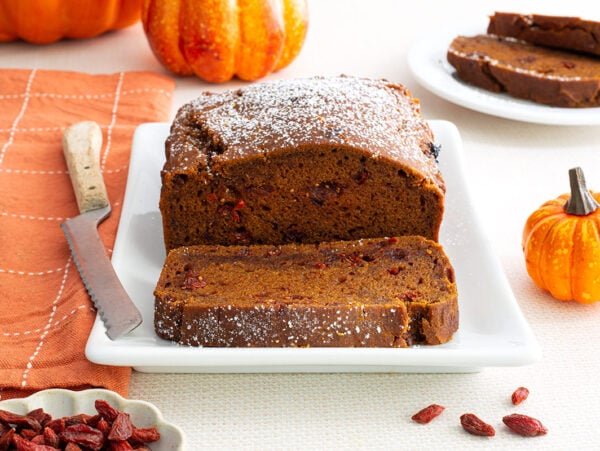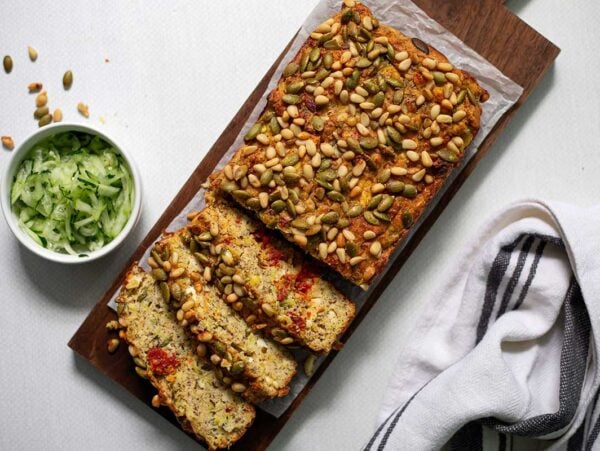Gluten Free Soft Bread Recipe
Updated Jun 13, 2018, Published Apr 03, 2013
This post contains affiliate links. Please see our disclosure policy.
For most people, a bread binge is consuming a lot of bread in a short period of time. For me, it is baking a lot of bread in a short period of time.
I was on a quest for an incredibly easy, soft, gluten free white (or sandwich) bread recipe that literally anyone could make. And since I have no patience, I wanted to be able to enjoy warm bread in an hour or so not an afternoon.
Aside from being dead simple to make, quick, soft, and tasty, I wanted the bread to be gum free. Psyllium husks are great for use in gluten free baking, they are cheaper and easier to come by than xanthan gum and don’t cause the tummy upsets that gums can for some people. While I have used psyllium husks in gluten free baking I had yet to try it in bread.
I feel a little bit of a ramble coming on so if you would prefer to just scroll down and get to the recipe, be my guest!
The first loaf I baked tasted fantastic, it was light, moist, and soft, it rose up beautifully and sliced well – pretty much everything I wanted – except it sunk in the middle. Not a lot, but enough to send me back to the drawing board (or in this case, kitchen.)
I should tell you that my husband said I could call the recipe a success; he loved the first loaf and didn’t understand why a little sinking in the center was such an issue. Additionally he thought the answer to the problem was to let the bread cool upside down on the cooling rack. I should also tell you that he is not a recipe developer and never will be.
So began the painstaking process of changing just on tiny thing at a time; a half teaspoon less yeast, a tad less salt, more sugar, less water, more psyllium husks, less psyllium husks… With each tiny correction I came closer and closer and the dent in the center began less and less pronounced.
The final change was to swap out the water I had been using in the recipe with milk; I figured a tad more protein couldn’t hurt. That did it – no more sinking!
Although I didn’t try it, I am thinking if you are dairy free you can use a high protein milk substitute like soy or you can just use water, it will sink slightly in the middle but it will still be soft, tasty, quick, easy, and gum free! And you can always try the letting the bread cool upside down suggestion from my hubby.
Prior to creating this Gluten Free Soft Bread recipe, I always thought a good stand mixer was essential to baking homemade gluten free bread. Interestingly, this recipe worked best with just a bowl and a whisk. Yep. Seriously, this recipe just keeps getting easier and easier.
Here are a few more thoughts and notes about the recipe, just in case you are interested.
- I used Erawan brand white rice flour, glutinous (sweet rice) flour, and tapioca starch. Asian flours are milled finer thus giving superior results when you are looking for a soft, even texture and they are about a third of the price of the flours and starches you get at the health food store.
- Look for psyllium husks in the supplement department of your health food store; it is typically sold where they sell colon cleansers and such. Try not to think about that when you are buying it.
- Be sure to grease AND flour your loaf pan; if you just grease it your bread may get a little soggy at the bottom.
- Heat your milk or water to warm (about 110 degrees) not hot. If you stick your finger in it, the liquid should feel warm and you can keep your finger in there for several seconds comfortably.
- Let your yeast proof until it is has a nice head of foam (like a glass of beer) about an inch thick. If you store your yeast in the fridge, it may take about 10 minutes.
- Measure your psyllium husks carefully. Trust me, after making 19 loaves of bread I found that exactly 1 level tablespoon is the correct amount.
- The batter for this bread is thinner than you might expect – it is similar to a thick pancake batter.
- Don’t let your batter rise too much; it should come just under the top of your pan for the best results.
So there you have it, soft, gluten free bread that could not be easier. Enjoy!
And one last thing! To make thing even easier, click here to see my cooking demonstration of this recipe on Daytime TV.

Gluten Free Soft Bread Recipe
Ingredients
- 1¼ cups warm, 110 degrees milk
- 4½ teaspoons dry active yeast
- 3 tablespoons sugar, divided use
- 1½ cups superfine or Asian white rice flour
- 1 cup tapioca starch
- ½ cup glutinous, sweet rice flour plus more for preparing the pan
- 1 tablespoon psyllium husks powder
- 1 teaspoon kosher salt
- 3 large eggs
- ¼ cup grapeseed or vegetable oil plus more for preparing the pan
Instructions
- Whisk together the milk, yeast, and 1 tablespoon of sugar. Let sit until the yeast has proofed (almost double in size with a head of foam about 1 inch thick), 5 – 10 minutes.
- Grease a 9.25 by 5.25 by 2.75 inch loaf pan with oil. Sprinkle in some sweet rice flour, coat the pan, and tap out the excess.
- Whisk the rice flour, tapioca starch, sweet rice flour, psyllium husks powder, salt, and remaining 2 tablespoons of sugar. Add the proofed yeast mixture, eggs, and oil, and whisk until smooth and lump free. Pour into the prepared pan, cover with a clean tea towel and let rise in a warm, draft free environment for 20 or 25 minutes or until the batter comes almost to the top of the pan. Preheat the oven to 375 while the bread is rising.
- Bake the bread for 30 – 40 minutes or until golden brown. Let cool in the pan then remove to a wire rack to finish cooling.
Nutrition
Nutrition information is automatically calculated, so should only be used as an approximation.
The views and opinions expressed on this blog are purely the blog owner’s. This blog accepts free manufacturers’ samples and forms of cash advertising, sponsorship, paid insertions or other forms of compensation. Affiliate links may be included in this post.
















Hi Carol,
Your simple bread is so amazing. Just want to ask if what will be the substitute for the milk? I don’t like much of milk.
Thanks for sharing.
You can just use water or rice milk. It may have a slight dip in the center without milk but it will taste great. And you can always try letting the bread cool upsoide down as my hubby suggests :)
Do you scoop your flour from the container or spoon it into the measuring cups to get 1.5 cups?
I scoop it from a canister, I find it is lighter that way.
Another fantastic gluten free recipe. I worship this website. I’m always on the lookout for wonderful gluten free bread recipes. I like to toss my bread recipes into my machine. I have three of them, a Cuisinart among them. They each have strengths and the aforementioned works well with gluten free. The machine kneads but with gluten free it’s not entirely necessary, only to bring the ingredients together so being able to adjust kneading time is helpful. Anyone else have machine faves?
That’s great Jackson. I have not tried this in a bread machine.
I tried this recipe this last week. My yeast proofed but not as high as called for in the recipe. I followed through anyway and ended up with really flat (but edible) biscuits. I am trying again today with new yeast. The yeast proofed really well. I am waiting for the bread to rise….it has been 30 minutes and it is not looking good. I was unable to find tapioca starch so ground my own from tapioca. Is that why it isn’t working? The dough is very stiff (cannot whisk it) and seems to really such up the liquid quickly. What do you think?
Hi Beverly. I have not tried this recipe with ground tapioca. Tapioca starch is fairly easy to find in health food stores or on the internet. Not excatly sure what’s goiung on here. My dough is more like athick batter. Maybe you could email specifics andI can be more helo – carol@simplycluten-free.com.
I have been looking for a gluten free bread and I was wondering if you have or know of a gluten free bread recipe that does not call for yeast or eggs? My daughter (and I to an extent) is gluten free but she also can not have eggs, yeast or dairy. I have used the egg replacer in my recipes and the dairy can be replaced but the yeast – not sure what to do with that for breads…any suggestions? Also, I will be trying your flour mix (homemade version) for the first time tomorrow and I am very excited! Hope I have good results….thanks for your response and many hours of trial and error to help all of us who are searching for good, easy and delicious gluten free options!
Hi Helen. You can try this recipe with a egg replacer. It is a quick bread. You can play with the seasoninings to suit your tastes. You could use 1 1/2 cups of my glour instead of the flours it calls for. I so understand about the trial and error! Good luck and I am sure the improved health will be worth the effort.
Hi Carol, Yes this recipe of yours is terrific! However, I can’t seem to keep the top from sinking. I’ve adjusted the liquid, given I live at a high altitude, added a tad more GF flour to no avail. Every loaf tastes great but I want it too look better. Do you have any other suggestions for me?
Thanks,
Cindy
Hi Cindy. I am not sure if the altitude is the problem. I live at sea level and I did a ton of tweaking to get the top not to sink in. Make sure the bread is not rising too much – just under level with the top of the pan is best, even if it only takes half the time to do so. You could also try degreasing the yeast just a tad. I have heard that decreasing the sugar or increasing the salt with help slow down rising but I am not an expert at baking at higher altitudes. However if you are happy with the taste I might suggest you try my hubby’s suggestion of cooling the loaf upside down on a cooling rack. It actually works pretty well!
Hi Carol, I am used to measuring flours etc by gram weight. Can you advise me of the gram weights for the rice, glutinous flours and tapioca starch. Anxious to try this bread!
Hi Janice,
This website might be of use to you. :) https://dish.allrecipes.com/cup-to-gram-conversions/
xo,
Carol
I love the bread. I did sink in the middle but most likely due to the fact I used potato starch as I cannot tolerate corn or tapioca starch. Do you know of an alternative that I can use in lieu of potato starch? I have coconut flour but don’t know if that would work or even how much to use. You may want to indicate in your recipes for those of us who are intolerant to tapioca that when substituting corn or potato starch they need to halve the amount used. 1 tbs corn or potato starch = 2 tbs tapioca starch. This may be why some are having issues with there end product.
Best recipe ever. My bread came out perfect. Thank you for sharing. What is the best way to store the bread after it cools.
Thanks Kim. To be honest we usually just eat it so fast storiung is not much of a problem howevr it is fine wrapped up in the fridge for a day or two – after that I suggest freezing it, Cut into slices and freeze, so easy to use that way!
Carol – I’m rising my first loaf of your Soft White Bread and I’m wondering, to what purpose is the psyillum husk powder in this recipe? Is it to add fiber? Can’t wait to try this bread. My hubbie is a big French bread and roll fan, so I’m hoping to WOW him with this so he’ll be convinced to get away from the other breads he’s been eating…… Thanks, Christy S
Hi Christy,
It adds stickiness to the dough and helps hold the bread together in lieu of xanthan or guar gum. Gluten is sticky and without it we need to add some back in there. Good luck! Hope the hubby is Wowed!